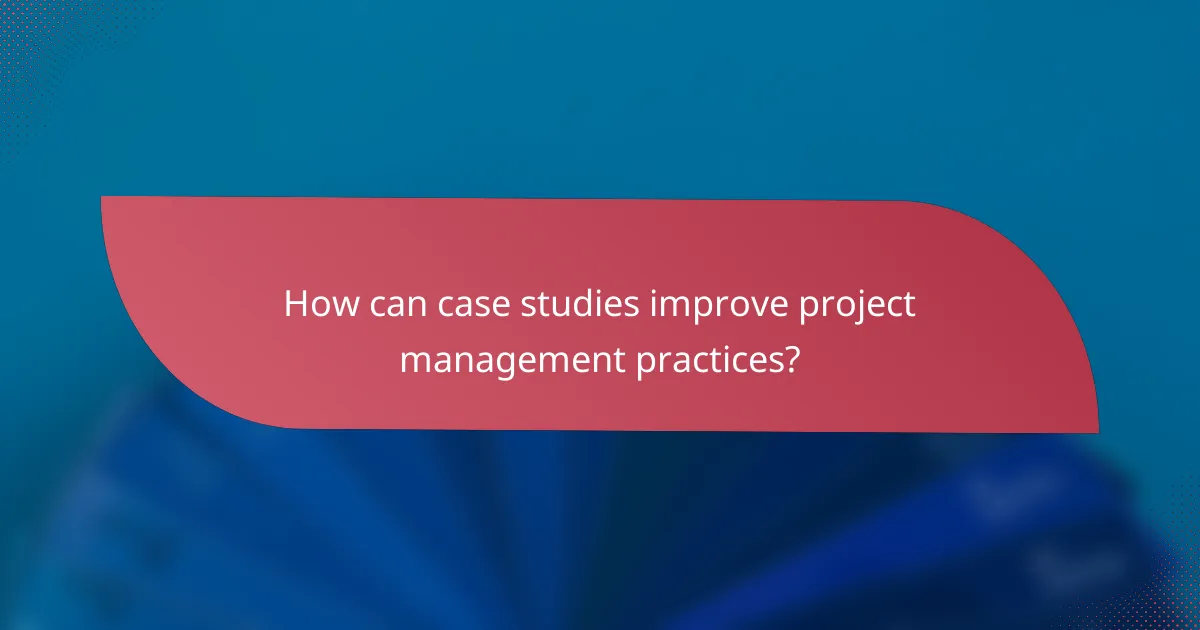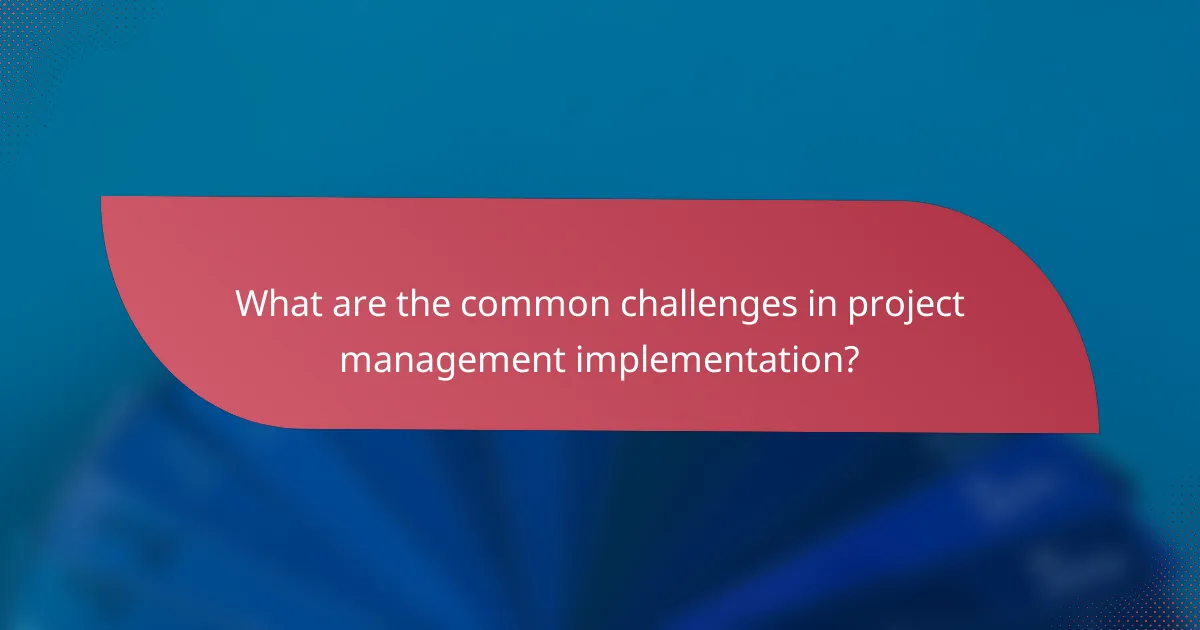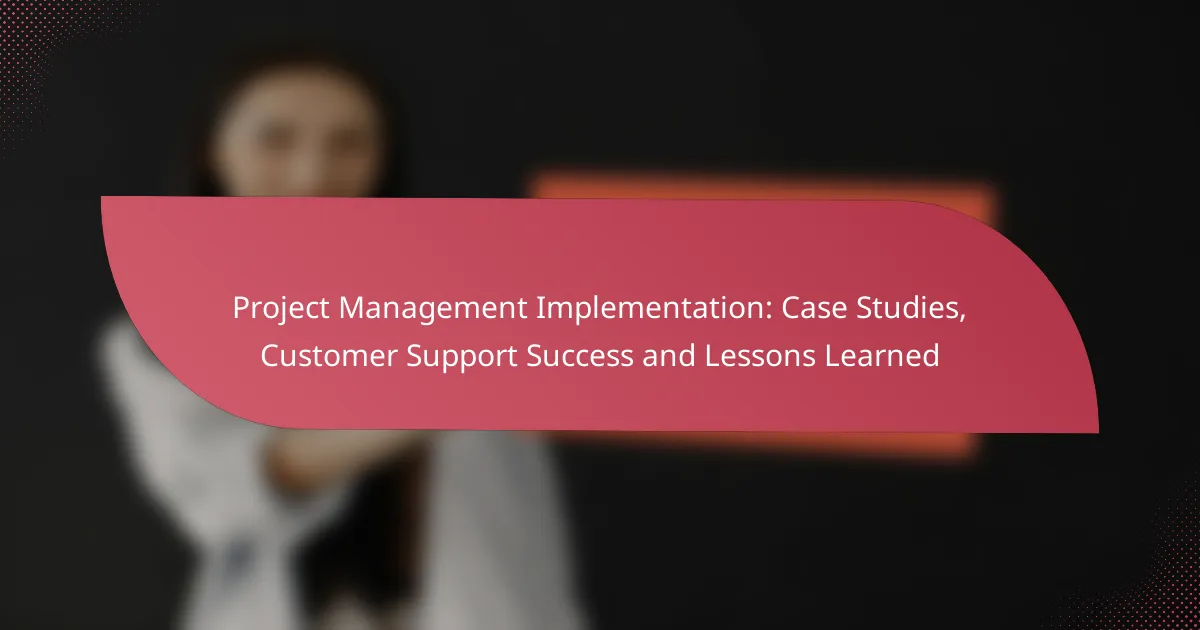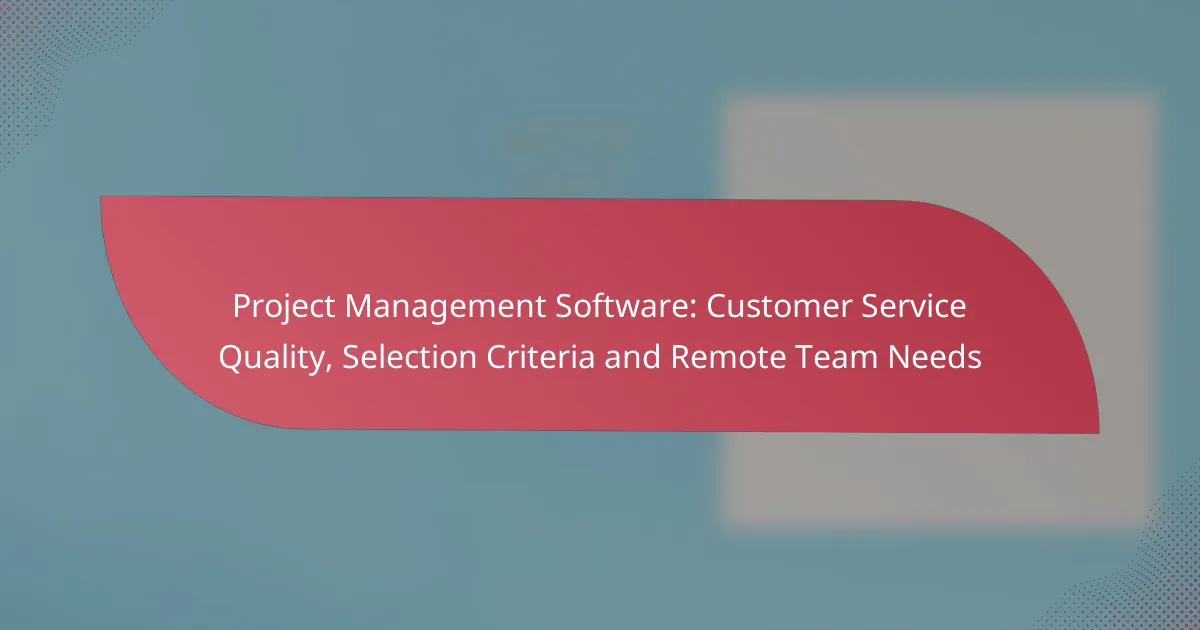Effective project management implementation is crucial for enhancing delivery and efficiency, with strategies tailored to the complexity of each project and the needs of stakeholders. By examining case studies, we can learn from real-life successes and challenges, gaining insights into effective methodologies and common pitfalls. Additionally, strong customer support practices play a vital role in project success, fostering collaboration and ensuring timely assistance throughout the project lifecycle.

What are the key project management implementation strategies?
Key project management implementation strategies focus on structured methodologies that enhance project delivery and efficiency. Selecting the right approach depends on project complexity, team dynamics, and stakeholder needs.
Agile methodology
Agile methodology emphasizes flexibility and iterative progress through small, incremental changes. It allows teams to adapt quickly to changing requirements, making it ideal for projects with uncertain or evolving scopes.
Key practices include regular stand-up meetings, sprints, and continuous feedback loops. Teams often use tools like Jira or Trello to manage tasks and track progress, ensuring transparency and collaboration.
Waterfall model
The Waterfall model is a linear and sequential approach where each phase must be completed before the next begins. This method is best suited for projects with well-defined requirements and minimal expected changes.
Common phases include requirements gathering, design, implementation, testing, and maintenance. While it provides clear milestones, it can be inflexible if project needs change mid-course.
Hybrid approach
A hybrid approach combines elements of both Agile and Waterfall methodologies to leverage their strengths. This strategy allows teams to adapt to changing requirements while maintaining structure for critical phases.
For instance, a team might use Waterfall for initial planning and Agile for development and testing. This flexibility can improve stakeholder satisfaction and project outcomes, especially in complex environments.
Lean project management
Lean project management focuses on maximizing value while minimizing waste. It encourages teams to identify and eliminate non-value-adding activities, streamlining processes for efficiency.
Key principles include continuous improvement, respect for people, and delivering value to customers. Techniques such as value stream mapping can help visualize processes and identify areas for enhancement.
Scrum framework
The Scrum framework is a specific Agile methodology that organizes work into time-boxed iterations called sprints. It emphasizes teamwork, accountability, and iterative progress toward a well-defined goal.
Scrum roles include the Product Owner, Scrum Master, and Development Team, each with distinct responsibilities. Regular ceremonies, such as sprint planning and retrospectives, foster collaboration and continuous improvement.

How can case studies improve project management practices?
Case studies enhance project management practices by providing real-life examples of successes and challenges faced during project execution. They offer insights into effective strategies, common pitfalls, and the impact of various methodologies on project outcomes.
Real-world examples
Real-world case studies illustrate how different organizations have navigated project management challenges. For instance, a tech company implemented Agile methodologies to reduce time-to-market, resulting in a 30% increase in project delivery speed. Another example is a construction firm that adopted Lean principles, which helped minimize waste and improve efficiency by up to 25%.
These examples highlight the importance of adapting project management strategies to fit specific industry needs and project types. By analyzing these cases, project managers can identify best practices that align with their organizational goals.
Success metrics
Success metrics derived from case studies often include key performance indicators (KPIs) such as project completion time, budget adherence, and stakeholder satisfaction. For example, a case study may reveal that a project completed 10% under budget while achieving an 85% satisfaction rate among stakeholders.
Using these metrics allows project managers to benchmark their performance against industry standards and make data-driven decisions to improve future projects. Regularly reviewing these success metrics can lead to continuous improvement in project management practices.
Lessons from failures
Case studies also provide valuable lessons from project failures, highlighting what went wrong and how similar mistakes can be avoided. For instance, a project that failed due to poor communication among team members can serve as a reminder of the importance of establishing clear communication channels from the outset.
By analyzing these failures, project managers can develop strategies to mitigate risks and enhance project outcomes. Common pitfalls include inadequate stakeholder engagement and insufficient resource allocation, both of which can be addressed through proactive planning and regular reviews.

What customer support practices enhance project management outcomes?
Effective customer support practices significantly improve project management outcomes by ensuring timely assistance, fostering collaboration, and enhancing communication. Key practices include providing round-the-clock support, establishing dedicated project teams, and implementing feedback loops to continuously refine processes.
24/7 support availability
Offering 24/7 support availability allows project teams to address issues as they arise, minimizing downtime and maintaining project momentum. This practice is especially crucial for global projects where team members may be in different time zones.
To implement this, consider using a mix of live chat, email, and ticketing systems that can handle inquiries at any hour. Utilizing automated responses for common questions can also help manage workload during off-hours.
Dedicated project support teams
Having dedicated project support teams ensures that specific resources are allocated to address project-related queries and challenges. These teams can provide tailored assistance, improving response times and the quality of support.
When forming these teams, ensure they are well-versed in the project’s goals and challenges. Regular training and updates can keep them aligned with project developments and customer needs.
Feedback loops
Implementing feedback loops is essential for continuous improvement in customer support and project management. Regularly soliciting feedback from team members and clients allows for adjustments to be made promptly, enhancing overall satisfaction.
Consider using surveys or direct interviews after project milestones to gather insights. Analyzing this feedback can reveal patterns and areas for improvement, leading to more effective support strategies over time.

What are the common challenges in project management implementation?
Common challenges in project management implementation include resource allocation issues, stakeholder engagement difficulties, and resistance to change. Addressing these challenges effectively can significantly enhance project success rates.
Resource allocation issues
Resource allocation issues arise when project managers struggle to assign the right amount of resources—such as time, money, and personnel—to various tasks. This can lead to delays, budget overruns, and team burnout. A practical approach is to regularly assess resource availability and adjust allocations based on project needs.
For instance, using project management software can help visualize resource distribution and identify bottlenecks. It’s advisable to maintain a flexible resource pool to adapt to changing project demands.
Stakeholder engagement
Stakeholder engagement is crucial for project success, yet many projects fail due to inadequate communication and involvement of key stakeholders. Ensuring that stakeholders are informed and their feedback is considered can foster a sense of ownership and commitment to the project.
Regular updates, meetings, and feedback sessions can enhance engagement. Tools like surveys or stakeholder analysis matrices can help identify and prioritize stakeholder interests and influence.
Change resistance
Change resistance occurs when team members or stakeholders are reluctant to adopt new processes or technologies introduced during a project. This resistance can stem from fear of the unknown or a lack of understanding of the benefits of change.
To mitigate resistance, it’s essential to communicate the reasons for change clearly and provide training to ease the transition. Engaging employees early in the change process can also help reduce apprehension and build support.

What criteria should be considered for selecting project management tools?
Selecting project management tools requires evaluating several key criteria to ensure they meet your team’s needs. Consider factors such as integration capabilities, user interface, scalability, and customer support to make an informed decision.
Integration capabilities
Integration capabilities refer to how well a project management tool can connect with other software applications your team uses. A tool that seamlessly integrates with platforms like Slack, Google Workspace, or accounting software can streamline workflows and reduce manual data entry.
When assessing integration options, look for tools that offer APIs or pre-built connectors. This allows for easier data sharing and enhances collaboration across different departments. For example, a project management tool that integrates with time-tracking software can help in monitoring project hours without switching between applications.
Common pitfalls include choosing a tool with limited integration options, which can lead to data silos and inefficiencies. Aim for tools that support a wide range of integrations, ideally those that are popular in your industry, to maximize functionality and ease of use.



